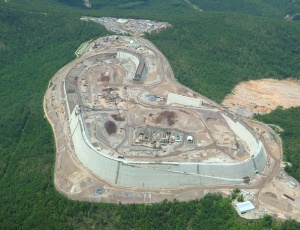In late April, southern Missouri�s 440-megawatt Taum Sauk hydroelectric plant began generating power for the first time since December 2005, when an old dam gave way and more than a billion gallons of water rushed down the side of Proffitt Mountain through the popular Johnson�s Shut-Ins State Park below.

Power utility AmerenUE awarded a joint venture named Ozark Constructors LLC the contract to rebuild the pumped-storage reservoir�this time using roller-compacted concrete (RCC), which has become an industry standard for dam construction because it�s less prone to cracking.
Lee Schermerhorn, vice president of joint venture partner ASI Constructors Inc. of Pueblo West, Colo., says the Taum Sauk project is the largest RCC dam in North America. Before Taum Sauk was complete, the biggest were in California and South Carolina, each requiring about a million cubic yards of RCC. The Missouri project took 2.8 million yds of RCC, plus another 300,000 yds of conventional concrete, for a total approaching the 3.3 million yds of concrete used to build Hoover Dam back in the 1930s.
�The old dam was actually taken down and put into a crusher, crushed into aggregate, remixed with cement and sand, and put back in as concrete and RCC,� Schermerhorn says. His company and joint venture partner Fred Weber Inc. of St. Louis recycled the old dam into a kidney-shaped ring, more than 6,000 ft long and varying in height between 80 and 160 ft.
The design, by Paul C. Rizzo Associates Inc. of Pittsburgh, holds almost 2 billion gallons of water.
�The schedule was the biggest challenge,� Schermerhorn says. Construction on the roughly half-billion-dollar project began in the fall of 2007 and was finished in late 2009. The reservoir was filled in February 2010 and hydro power began heading to St. Louis in late April.
The RCC was delivered from an onsite plant to the dam area via conveyor belt and loaded into dump trucks to haul into place. Schermerhorn says that using standard 10-yard mixer trucks would have been far too slow.
�We poured 8,000 to 14,000 yds every day. It�s unbelievable.�

Post a comment to this article
Report Abusive Comment